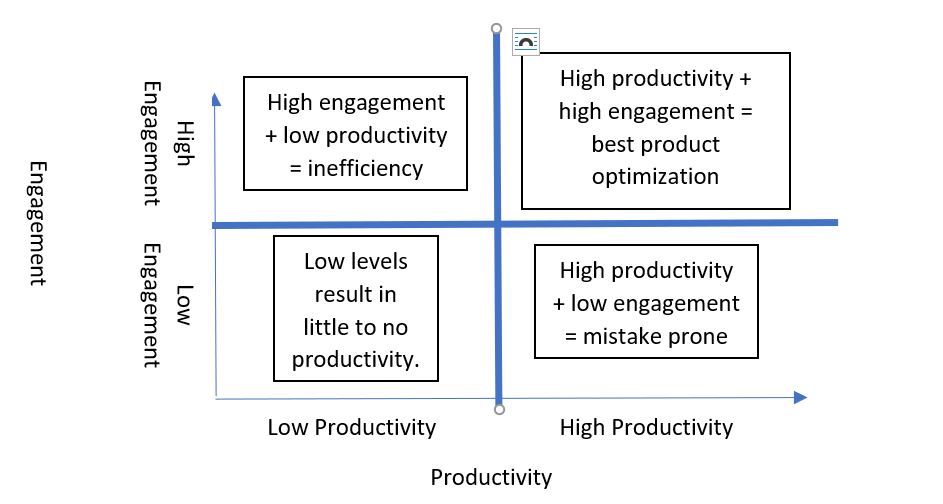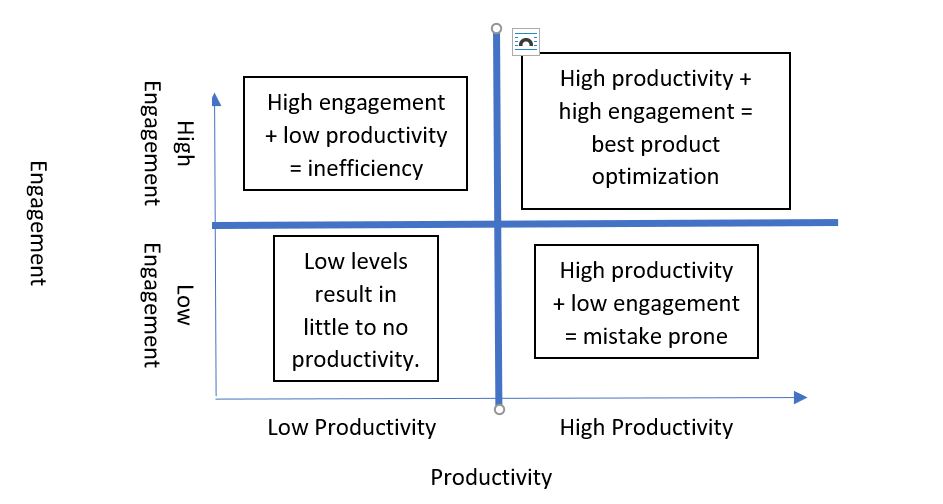
Educators know the importance of having highly engaged, productive students, whether they learn online or in person. It tells a teacher whether their classes can understand Key concepts or if additional time is needed to revisit the lesson.
But I recently thought about something that hit a cord, and I know it will resonate with you, especially since engagement and productivity can transfer to the corporate world on their bottom line.
Whether you are an educator or not, we can be engaged in our work, but does it mean we are productive?
Its authentic engagement gives us some sense of comfort knowing that people acknowledge us, but it’s the productivity we must focus on while building up our engagement.
Take a moment and think about the chart below.

Engagement starts the process of a student’s willingness to learn, but when the engagement turns productive, one realizes how much others know or don’t know.
The Four Components Of Highly Engaged Productive Students
Some wonder how this can be done, but it boils down to four essential components from my experiences. The best part is it costs nothing but a bit of time initially.
- Build a healthy relationship. No ground will be covered until students understand that trust is in place and that the teacher commits to building relationships.
- Listen and watch. If we took the time to listen, there would be so many things we would pick up. From watching someone’s body language to sitting down and asking about their next steps after graduation, you can learn much about your students. From those conversations, you can help guide and coach them to new goals and levels of awareness.
- Give students the tools they need to succeed. When we have the tools needed to perform a task, it helps change our mindset to see the result. Tools help to reduce errors and speed up tasks. When students choose the tools they want, they become empowered, instilling leadership skills.
- Collaborate on the result. When tasks are completed, time for collaboration should be factored into the assignment. Exchanging conversations allows for reflecting and celebrating while providing closure where one knows that the work they submitted was productive and engaging.
Having these components in place does more than reaffirming someone. It sets the precedence for everyone matters just as much as their academics.
But there’s more to it other than having highly engaged, productive students.
We must factor in how we can do the same for employees.
Four Components Of Highly Engaged Productive Employees
Several components can contribute to highly engaged and productive employees, but here are four key factors:
- Clear and specific goals: Employees must clearly understand what is expected of them, their goals, and how their work aligns with the organization’s objectives. This helps to create a sense of purpose and direction and enables employees to focus their efforts on the most important tasks.
2. Supportive work environment: Employees need to feel supported in their work environment, both by their managers and by their colleagues. This can include providing resources and tools needed to do the job, offering regular feedback and recognition, and creating a culture of collaboration and teamwork.
3. Opportunities for growth and development: Employees want to feel that they are learning and growing in their roles and that there are opportunities for advancement within the organization. This can include offering training and development programs, providing coaching and mentoring, and creating a culture that values continuous learning and improvement.
4. Work-life balance: Employees need to feel that they have a reasonable balance between their work and personal life. This can include offering flexible work arrangements, providing adequate time off and vacation time, and promoting healthy work habits and stress-reduction techniques. A good work-life balance can help employees feel more engaged and motivated in their work, leading to greater productivity and job satisfaction.
Do you have any other suggestions for making a highly engaged and productive employee? I love to hear what you have to say, or contact us if you have a specific question.



